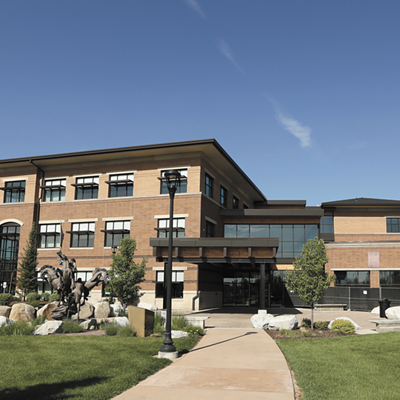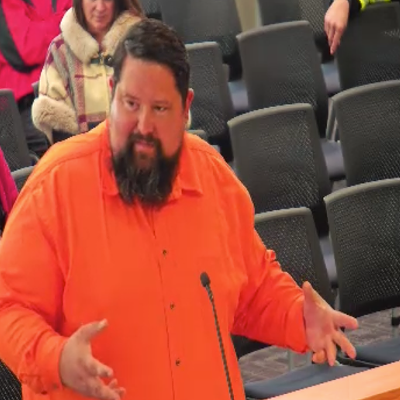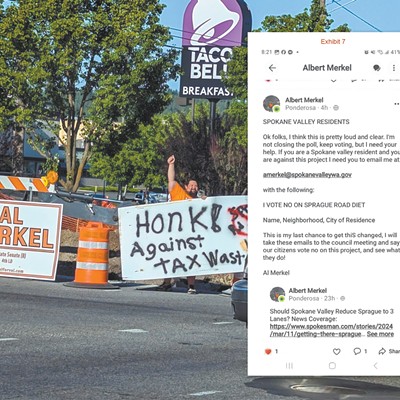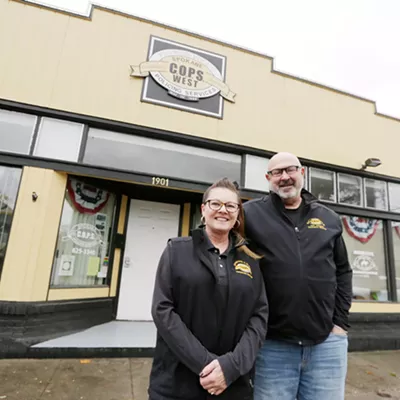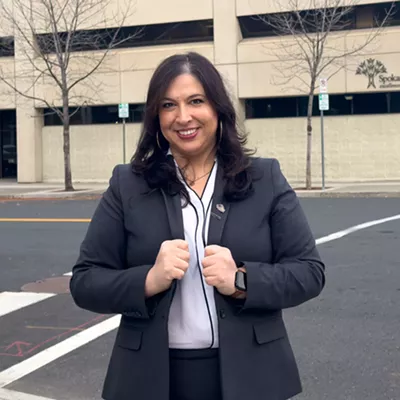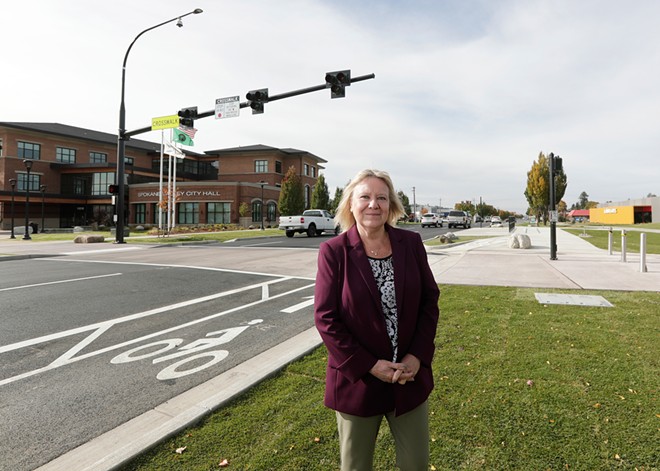
Spokane Valley has finished its nearly $4.6 million Sprague Avenue stormwater and multimodal project, which reduced the road from five to three lanes between North University Road and North Herald Road, where Balfour Park and Spokane Valley City Hall are located.
Road construction started in June and was completed in October. The work included many changes, such as incorporating traffic signals, bike lane improvements, a pedestrian mid-block crosswalk and a stormwater bio-infiltration system.
CRITICISM
The half-mile stormwater project has received plenty of scrutiny and debate. Some residents have told the Spokane Valley City Council that the money would have been better spent on other needs, such as the city's shortage of law enforcement officers or the fentanyl crisis.The project's most vocal critic has been City Council member Al Merkel, who voted against awarding a $3 million contract for the project to Spokane-based contractor Halme Construction in May.
The bid was about $600,000 cheaper than estimated by city engineers and covered construction elements such as stormwater upgrades, landscaping, pedestrian lights and infrastructure for future sidewalk lights.
Merkel has repeatedly criticized the project on the Nextdoor app. In one post on the site he said, "I'm sorry I couldn't stop the project, I tried. Should have spent the money on more police."
Spokane Valley Mayor Pam Haley says the main focus of the project was on stormwater improvements, which were funded through stormwater-specific grants.
"The biggest challenge is the citizens don't understand because they've been fed some misinformation pretty consistently," Haley says. "Most of the money used was actually stormwater money that could only be used for stormwater improvements."
The Inlander used Nextdoor to ask Spokane Valley residents for their perspectives on the project.
"My stance is I'm very disappointed at our officials for putting money to a vanity project when we have a drug crisis, homeless needing shelter, police shortage and schools who can always use any extra money," Spokane Valley resident Alana Higby tells the Inlander by email.
Higby's sentiments were shared by many residents on Nextdoor, who felt the money could have been better spent.
Of the nearly $4.6 million price tag, nearly $1.38 million came from a Coronavirus Local Fiscal Recovery Fund grant for sewer or stormwater projects to improve water quality; another $64,125 came from a Washington state Department of Ecology grant for stormwater improvement; and a $556,400 grant from the state Department of Transportation paid for the pedestrian crossing. About half of the project was paid for from dedicated city funds (most grants require local matching funds).
UPGRADES
City Services Administrator Gloria Mantz has worked for Spokane Valley for 20 years in multiple jobs, including her start with the city as a stormwater engineer. She says the project offered the opportunity to address multiple issues simultaneously.Mantz says the state Department of Ecology requires that dry wells that leak into the Spokane Valley-Rathdrum Prairie Aquifer be pretreated. A dry well is a concrete cylinder that collects unwanted street-level runoff and stormwater.
"We have a lot of dry wells throughout the city that do not have any pretreatment," Mantz says. "So we've been trying to tackle some of those main arterials where we have more trouble, more vehicles that travel the roadway, and so that's more potential to contaminate the groundwater."
New dry wells installed during the project utilize bio-infiltration swales, which are topped with vegetation and soil to filter stormwater of pollutants before it infiltrates deeper into the ground.
Mantz says narrowing the roadway to create "green spaces" was more practical and less expensive than maintaining the same number of lanes because of the costs associated with moving existing underground utility infrastructure and trees along the street.
It also solved other issues with pedestrian safety.
Mantz says there is plenty of pedestrian traffic along that stretch of Sprague because of the library, City Hall, Balfour Park and residential apartments nearby.
A 2022 study found that more than 60% of drivers exceeded the posted 35 mph speed limit on Sprague, with over 120 drivers exceeding 50 mph on a typical day.
The reduced lanes and the addition of a signalized pedestrian crosswalk from City Hall to Balfour Park will make it significantly safer and slow traffic. A new bus stop was also added in collaboration with the Spokane Transit Authority, a partnership Haley embraced.
"I'm very happy we have a lot of partnerships with the county, but we're a contract city, so we're used to partnerships and working with people that way," Haley says. "Everything's been positive that I've been able to see."
A DOWNTOWN?
Spokane Valley currently doesn't plan to build a designated downtown or pedestrian-friendly hub like the Garland District, Kendall Yards or downtown Spokane. However, Haley and Mantz both feel the area of the project has organic growth potential because many longtime residents regard it as a city hub."There was a lot of sentiment for this area because ... there used to be a mall here, and this is where people concentrated, and this is the closest to a downtown that Spokane Valley has," Mantz says.
Haley says the area is a focal point because of government services, businesses and residential density nearby. She believes there will be more foot traffic once Balfour Park is completed.
Haley says many residents have been pleasantly surprised by the project, and even more will enjoy the area's safer access to public transportation.
"When they made Sprague one-way, it had a surfeit of lanes which encourages drivers to go faster," Spokane Valley resident Julie Rosenoff tells the Inlander by email.
Rosenoff says the shorter pedestrian crossing makes it easier to visit the library. She hopes the project will revitalize the area and put Spokane Valley on the map.
Resident Diane Kipp's 43-year-old son, Ryan, has autism and an intellectual disability but loves going to the public library. Before the project, she was worried about him making trips on his own.
"However, with the narrowing of the roadway and the crosswalk and stoplight directly between City Hall and the library, I am hopeful that Ryan will be able to resume his independent trips to the library, which will significantly impact his life as the library is his favorite place," Kipp tells the Inlander. ♦



